Extern Life at the American Fondouk
Every pony has an owner, and other lessons from my time at the American Fondouk
by Isabel Francisco V’18
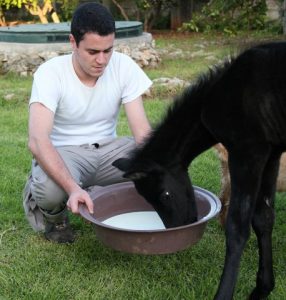
We’re at Monday morning rounds when they introduce him. “This mule presented last weekend for tetanus,” someone says, and everybody falls quiet in the tight circle we’ve formed outside his stall. His door’s top and bottom halves are shut completely, so that opening the top half is like opening a box. In that shadowy space a skinny brown mule starts at the sounds from outside, and then lurches back and forth. Step by hitching step, he’s turning in a circle to face us, all four limbs braced stiff and uncomfortably straight. His ears are filled with cotton and wrapped in bandages. When his face is turned towards us, it happens so quickly I’m unsure it’s real: pink wet eyelid stretches briefly across both eyes, and then snaps back into place like window blinds. The image will be forever burned into my mind: tetanus cases “flash” their third eyelids, and it’s like something out of a Ridley Scott film.
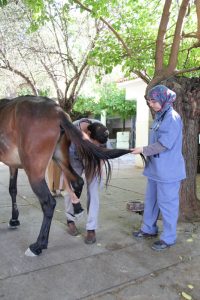 The student on the case lists off the mule’s current medications: drugs to sedate, drugs to relax those tensed muscles, penicillin and serum antitoxin. The vets decide that we’ll keep the door closed to shut him away from the morning noise. I think about how far I have traveled to get here: the long flight to Casablanca; the train ride to Fes; the taxi from the train station and my first glimpse of the stunning blue gates to the medina. Before that, my childhood in the Philippines; the 23 hour-long journey from Manila to college and then vet school in New England; the many times I thought I was going to drop out; and my meetings with Dr. Melissa Mazan, who told me about this place: the American Fondouk, charity hospital to the working equids of Fes, Morocco. I watch that mule looking back at us with a disease that the first world has vaccinated into rarity, and I think, this is what has brought me so far away from home.
The student on the case lists off the mule’s current medications: drugs to sedate, drugs to relax those tensed muscles, penicillin and serum antitoxin. The vets decide that we’ll keep the door closed to shut him away from the morning noise. I think about how far I have traveled to get here: the long flight to Casablanca; the train ride to Fes; the taxi from the train station and my first glimpse of the stunning blue gates to the medina. Before that, my childhood in the Philippines; the 23 hour-long journey from Manila to college and then vet school in New England; the many times I thought I was going to drop out; and my meetings with Dr. Melissa Mazan, who told me about this place: the American Fondouk, charity hospital to the working equids of Fes, Morocco. I watch that mule looking back at us with a disease that the first world has vaccinated into rarity, and I think, this is what has brought me so far away from home.
I start my two-week externship at the Fondouk right after my Large Animal Medicine rotation, and our days are structured very similarly. We do treatments and physical exams in the morning, scribbling notes about our cases that we’ll present at morning rounds. Our meals and bedtimes are organized around treatment times, and we divide up the on-call shifts. The doctors grill us with questions: what bacteria is responsible for strangles? What percent of septic joints come back with a positive culture? What is the mechanism of action of gentamicin? It feels like school, but with a few key differences: our patients walk up to the clinic, sometimes limping for over an hour; all of them are working animals, and so none of them have names; all treatment for these horses, donkeys and mules is free. The first time a donkey braying wakes me in the middle of the night, I think it’s a foghorn, or some terrible fire alarm. I never really learn to sleep through it.
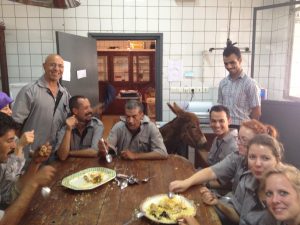 No matter their country of origin, horses, donkeys and mules will colic, and we work up colics in the same systematic way: each step gives us more information that might lead to another step, like a choose-your-own-adventure book. I learn that most of the colics at the Fondouk are impactions, caused by the dry bean hay commonly fed to livestock. The mule that walks into the clinic my second week has been eating only this in the 110-degree heat. We sedate him and I get to pass the nasogastric tube, which gives us back a few chunks of feed material. I also get to rectal him after the vet does – my first ever rectal on a colic – and Dr. Souhail, a Moroccan vet at the Fondouk, talks me through it. “His cecum isn’t very palpable on the right, but if you reach ventrally you’ll feel it,” he says. “Something firm and doughy that shouldn’t be there.” It feels like something wadded up under a sheet: my first impaction. “I think I feel it,” I tell him. Dr. Souhail nods and then says, “Good. So what do you want to do for this guy?”
No matter their country of origin, horses, donkeys and mules will colic, and we work up colics in the same systematic way: each step gives us more information that might lead to another step, like a choose-your-own-adventure book. I learn that most of the colics at the Fondouk are impactions, caused by the dry bean hay commonly fed to livestock. The mule that walks into the clinic my second week has been eating only this in the 110-degree heat. We sedate him and I get to pass the nasogastric tube, which gives us back a few chunks of feed material. I also get to rectal him after the vet does – my first ever rectal on a colic – and Dr. Souhail, a Moroccan vet at the Fondouk, talks me through it. “His cecum isn’t very palpable on the right, but if you reach ventrally you’ll feel it,” he says. “Something firm and doughy that shouldn’t be there.” It feels like something wadded up under a sheet: my first impaction. “I think I feel it,” I tell him. Dr. Souhail nods and then says, “Good. So what do you want to do for this guy?”
I’m repeatedly reminded that I am lucky to go to vet school in the first world: every time we need ice, we take recycled plastic jugs and bottles out of the clinic freezer and break the pieces apart on the paved courtyard. Every time we tap a joint or abdomen, we stain and read the cytologies ourselves, hoping we finally know what toxic neutrophils look like. There is no surgical option for colic cases, so we medically manage them as best as we can. “You have to remember that behind each of these animals is a family,” Dr. Souhail says. “We go pretty far, until it’s not fair to them anymore.” I learn that for the most part the language and the work of large animal medicine is the same – it’s the stakes that feel different.
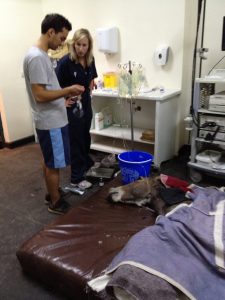 The caseload is intense. (The caseload is ridiculous.) At one point, we have the tetanus mule, a strangles suspect, a paraphimosis, a radial nerve paralysis, and an upward-fixating patella in the hospital at the same time. One day a fleabitten grey mule walks calmly into the clinic with a slash of red across his neck – a laceration that has split his trachea open. He recovers from surgery and proceeds to have the best appetite for hay in the entire hospital. Every night while looking at the lists of treatments I’m stunned; I know I learned about these things in classes, but seeing all of them in rapid succession is disorienting.
The caseload is intense. (The caseload is ridiculous.) At one point, we have the tetanus mule, a strangles suspect, a paraphimosis, a radial nerve paralysis, and an upward-fixating patella in the hospital at the same time. One day a fleabitten grey mule walks calmly into the clinic with a slash of red across his neck – a laceration that has split his trachea open. He recovers from surgery and proceeds to have the best appetite for hay in the entire hospital. Every night while looking at the lists of treatments I’m stunned; I know I learned about these things in classes, but seeing all of them in rapid succession is disorienting.
Because the cost of treatment is no longer a concern, each one of these patients gets the same stellar standard of care, from bandaging to hot packing to antibiotics to surgery. Sometimes the complaints are unexpectedly familiar; I see one owner greeted with familiar smiles as he walks his two big mules through the double doors. “Those mules have hock arthritis, and he brings them in for injections a few times a year,” somebody tells me – just another owner who wants hocks done. I can’t speak Arabic, but I see the concern in each owner’s eyes as they gesture to their animals, and the relief when we tell them we can fix the problem. I realize that I am finally using whatever knowledge I’ve retained from the hundreds of PowerPoints we studied, and sharing it with those who had nowhere to learn it themselves. I can’t help but think about how many times I’ve skipped class or complained about lectures that bored me, all the while enjoying access to so, so much.
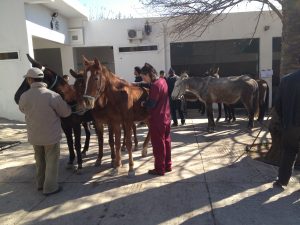 Possibly the best part is that I am discovering all this alongside other externs who have almost nothing in common with me. They come from Morocco, California, Scotland, Tunisia, the Czech Republic; between us we have five different languages and we teach each other the word ‘horse’ in every one. One slow day Dr. Souhail gathers us for teaching rounds on antibiotics, and I learn that every vet student in the world reacts the same way when we don’t know the answers to pharmacology questions. What we do know is that we have been drawn here by the same conviction: that working equid medicine saves lives and livelihoods every day, and so we want to do it. One extern tells me about his visit to a travel clinic before his flight to Fes. “The guy who gave me my shots kept saying, Why are you doing work for animals when you could be helping poor people instead? I told him, I am helping poor people. Now give me my shots!”
Possibly the best part is that I am discovering all this alongside other externs who have almost nothing in common with me. They come from Morocco, California, Scotland, Tunisia, the Czech Republic; between us we have five different languages and we teach each other the word ‘horse’ in every one. One slow day Dr. Souhail gathers us for teaching rounds on antibiotics, and I learn that every vet student in the world reacts the same way when we don’t know the answers to pharmacology questions. What we do know is that we have been drawn here by the same conviction: that working equid medicine saves lives and livelihoods every day, and so we want to do it. One extern tells me about his visit to a travel clinic before his flight to Fes. “The guy who gave me my shots kept saying, Why are you doing work for animals when you could be helping poor people instead? I told him, I am helping poor people. Now give me my shots!”
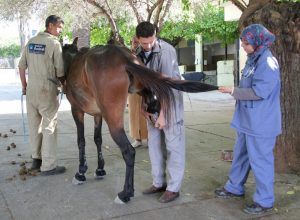 Two days before I leave the Fondouk, Dr. Souhail talks me through my very first abdominocentesis, on yet another colicking mule. I trace my way back from the xiphoid, move right of midline, poke through, and wait. When the first drop appears, I can’t help but grin. It stays with me through the plane ride home, this rush from discovering what I can actually do with my many years of school. I’ve been trying so long to figure out how I want to use the tremendous opportunities I’ve been given, while sharing them with those who have no such privileges. My time at the Fondouk has showed me that this is possible, and that I am not alone in wanting to do this with my career.
Two days before I leave the Fondouk, Dr. Souhail talks me through my very first abdominocentesis, on yet another colicking mule. I trace my way back from the xiphoid, move right of midline, poke through, and wait. When the first drop appears, I can’t help but grin. It stays with me through the plane ride home, this rush from discovering what I can actually do with my many years of school. I’ve been trying so long to figure out how I want to use the tremendous opportunities I’ve been given, while sharing them with those who have no such privileges. My time at the Fondouk has showed me that this is possible, and that I am not alone in wanting to do this with my career.
When I was very young, my parents used to take me to a tourist trail riding place in the mountains, a popular summer spot for Filipinos looking to escape the heat. We’d drive up and see dozens of native ponies tethered in a long line so that children could choose which ones they wanted to ride. Still other ponies pulled carts or carried produce down the road; back then, I only had eyes for the white ones. Today, I remember the dozens more that stood the whole day waiting to catch some little girl’s eye, and their owners standing nearby as trail guides, hoping to make a day’s income. Every animal has an owner, they tell us at vet school. At night I dream about that long line of ponies, and the ways I am learning to help theirs.


